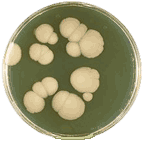Papers in the Biological Sciences
Document Type
Article
Date of this Version
1-2014
Citation
THE JOURNAL OF BIOLOGICAL CHEMISTRY VOL. 289, NO. 3, pp. 1662–1674, January 17, 2014.
Abstract
Methylglyoxal is a cytotoxic reactive carbonyl compound produced by central metabolism. Dedicated glyoxalases convert methylglyoxal to D-lactate using multiple catalytic strategies. In this study, the DJ-1 superfamily member ORF 19.251/GLX3 from Candida albicans is shown to possess glyoxalase activity, making this the first demonstrated glutathione-independent glyoxalase in fungi. The crystal structure of Glx3p indicates that the protein is a monomer containing the catalytic triad Cys136- His137-Glu168. Purified Glx3p has an in vitro methylglyoxalase activity (Km = 5.5 mM andkcat = 7.8 s-1) that is significantly greater than that of more distantly related members of the DJ-1 superfamily. A close Glx3p homolog from Saccharomyces cerevisiae (YDR533C/Hsp31) also has glyoxalase activity, suggesting that fungal members of the Hsp31 clade of the DJ-1 superfamily are all probable glutathione-independent glyoxalases. A homozygous glx3 null mutant in C. albicans strain SC5314 displays greater sensitivity to millimolar levels of exogenous methylglyoxal, elevated levels of intracellular methylglyoxal, and carbon source-dependent growth defects, especially when grown on glycerol. These phenotypic defects are complemented by restoration of the wild-type GLX3 locus. The growth defect of Glx3-deficient cells in glycerol is also partially complemented by added inorganic phosphate, which is not observed for wild-type or glucose-grown cells. Therefore, C. albicans Glx3 and its fungal homologs are physiologically relevant glutathione- independent glyoxalases that are not redundant with the previously characterized glutathione-dependent GLO1/GLO2 system. In addition to its role in detoxifying glyoxals, Glx3 and its close homologs may have other important roles in stress response.
Included in
Environmental Microbiology and Microbial Ecology Commons, Other Life Sciences Commons, Pathogenic Microbiology Commons



Comments
Copyright © 2014 by The American Society for Biochemistry and Molecular Biology, Inc. Used by permission.